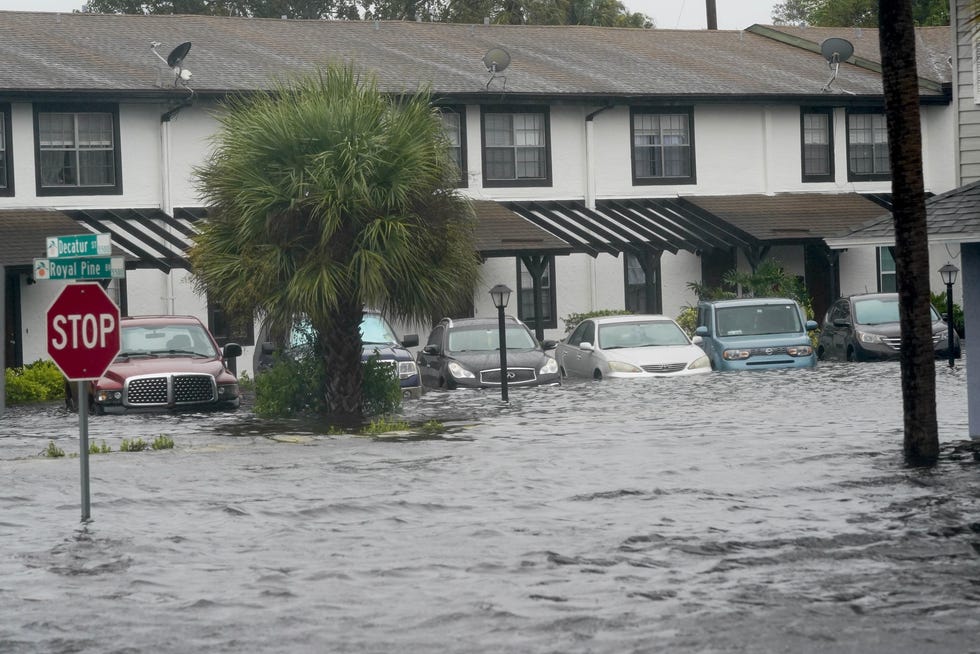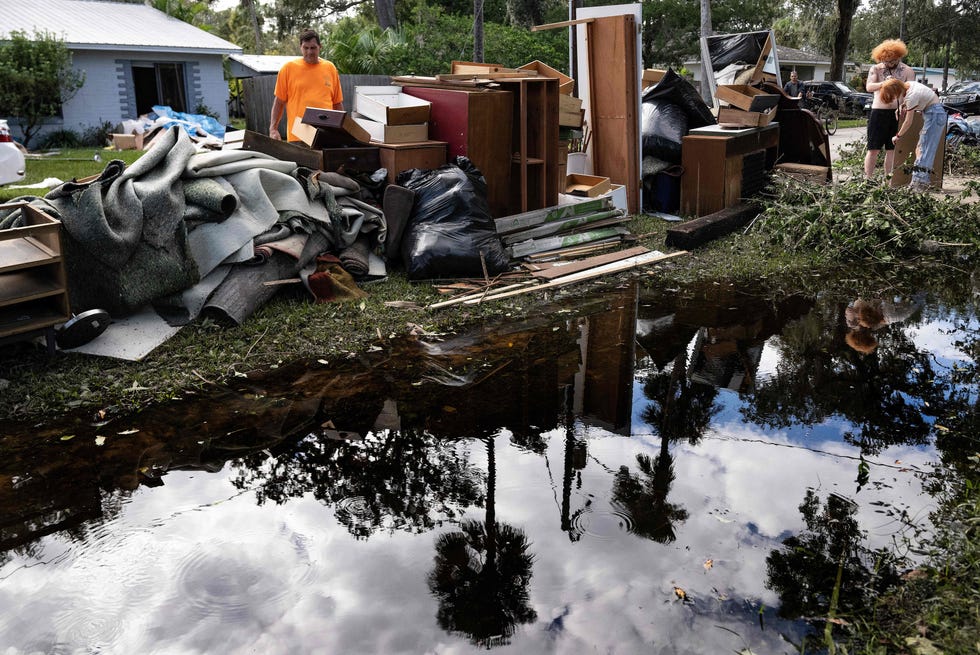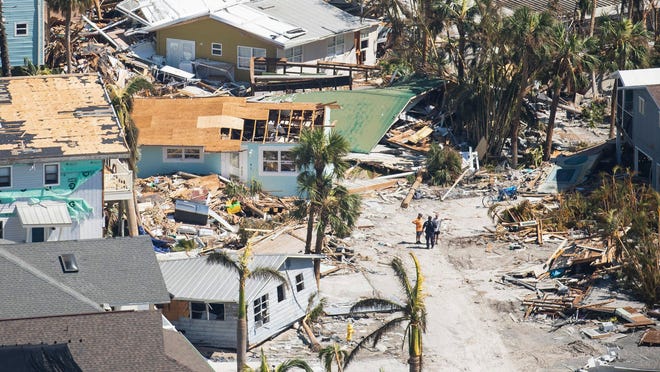Kimberly Lenehan Payano evacuated her North Fort Myers home during Hurricane Irma five years ago under dire warnings of storm surge and winds, then returned to an untouched house.
She decided not to leave for Hurricane Ian.
“It was the biggest mistake I ever made in my life. Big, big mistake,” Payano said this week.
Many of her neighbors stayed too, some not even boarding up windows. She still doesn’t know how they fared. If not for a couple of men with a small boat, she and her 12-year-old son could have been among dozens who died.
The rising death toll in Florida, now at 84, is confirmation many did not evacuate.
Including five deaths in North Carolina and one in Virginia, Ian ranks among the continental United States’ top 30 deadliest storms. It’s also the 11th storm in the last 22 years to claim more than 50 lives on the mainland.
With warmer ocean temperatures driving increasing rainfall and other climate-related changes forecast to occur, researchers predict bigger and even deadlier disasters.
“The risk posed by these storms is only going to increase … because of sea level rise and increasing population density,” said Amber Silver, a disaster researcher and assistant professor at the University of Albany in New York. “When you have more and more people in vulnerable regions becoming increasingly vulnerable due to global climate change and sea level rise, we’re going to see some of these shocking events with large death tolls and large economic losses.”
THERE ARE ‘NO EASY FIXES’ IN FLORIDA:But could Hurricane Ian’s havoc bring a call for better planning?
WATCH:Inside the search for Hurricane Ian’s survivors
The Ian-related deaths illustrate how the impacts of a disaster aren’t just driven by a hurricane’s strength, said Stephen Strader, associate professor at Villanova University. They’re influenced by how vulnerable people are and the choices they make.
“We’re seeing more people than ever before moving to the coastlines and putting themselves into vulnerable positions,” Strader said. Florida is a prime example. “Since Hurricane Andrew (in 1992), Florida’s population has increased 60% and the number of homes has doubled. That means more people in the path.”
The state’s population over the age of 65 is growing and that increases the risks because it may be harder for those individuals to evacuate, researchers said. The average age among the confirmed deaths in Ian so far is nearly 71.
Many of the hurricane-related deaths reported in Florida were among people who didn’t evacuate ahead of Ian’s 150-mph winds and storm surge, despite forecasts and warnings from government officials.
At least 10 people drowned inside their homes. Others were found on beaches and among piles of debris.
Payano’s narrow escape and the many deaths reflect the challenges of communicating personal risk to people in vulnerable areas as they are making life and death decisions, Silver said. “It’s never a simple ‘yes or no’ question. It’s when and where and how long? And can I afford to leave?”
It’s a very emotional time, in a situation with high uncertainty and urgency, she said. “That’s a really uncomfortable feeling.”
People have “a strong sense of home and place,” said Robbie M. Parks, assistant professor of environmental health sciences at Columbia University. “If their evacuation prospects are a shelter and lying down with strangers, they may not want to evacuate.”
As they try to make their decisions, people go through a process of seeking out information, conferring with friends, neighbors and family, Silver said.
That may include misinformation.
“The lack of universal truth in society permeates pandemics. It permeates natural disasters,” Parks said. “So people may not be completely faithful that the news they’re hearing about hurricanes is true. That’s a very deep-set problem that is much harder to fix.”
From the outside looking in, it’s easy to make judgments about how people made their decisions, said disaster researcher Samantha Montano, an assistant professor at Massachusetts Maritime Academy. But, she said, “People generally are trying to make the best decisions for them and their families with the resources they have.”
Individual circumstances and whether people have resources to evacuate are a major influence, said Montano. “Do they have a car? Do they have money for gas? Do they have money for a hotel room?”
Residents in many hurricane-prone areas also fail to understand the dangers of water.
Hurricane Andrew in 1992 taught Floridians to fear the wind, Strader said, but as many as 90% of hurricane deaths are attributed to storm surge and rainfall.
AFTER HURRICANE IAN WAS GONE, ‘THEN ALL THE WATER CAME’:Flooding stuns Florida’s DeSoto County
In Volusia County – on the opposite side of Florida from Ian’s landfall – three people died from drowning and hundreds were rescued from flash flooding that resulted from the intense rain and surging sea.
State medical examiners attribute more than half of Ian’s deaths so far to drowning.
Things turned grim fast for Payano as the Caloosahatchee River topped its banks and rushed into her home. They had planned to drive away if the water started rising, then “half of a neighbor’s home landed in the driveway” and pinned them in.
‘WE GET IT LAST’:After Hurricane Ian hits Fort Myers, Black neighborhood residents say they aren’t counting on much help
As the water rose, she posted a plea for help in a Facebook video, and they watched a barge float by, then a sofa.
Waist-high water swirled around them when rescuers arrived and lifted her son, the family dog and the cat, tucked into a bag, into a small rowboat. Shoving her cellphone and charger into her bra, and without grabbing her glasses or her purse, Payano stepped out of the door into neck-deep water.
She was swept off her feet a couple of times and went under as she and rescuers pulled the boat with her son and pets more than a mile to a staging area on a bridge, she said. “We got about halfway and I said, ‘Go without me.’ I didn’t care if I was going to die right there in the water.”
Now staying with friends temporarily, Payano wonders if she should rebuild on her lot with 200-feet of frontage on the Caloosahatchee River, or cut her losses and move?
She has homeowners and flood insurance, but it’s a tough choice she’s heard other friends and neighbors debating.
As she looks at the devastation around her and considers the forecast for more extreme rainfall, warmer oceans and rising sea levels, she’s not really sure she wants to stay. “If I didn’t have a son in school, I’d be leaving the state of Florida right now.”






